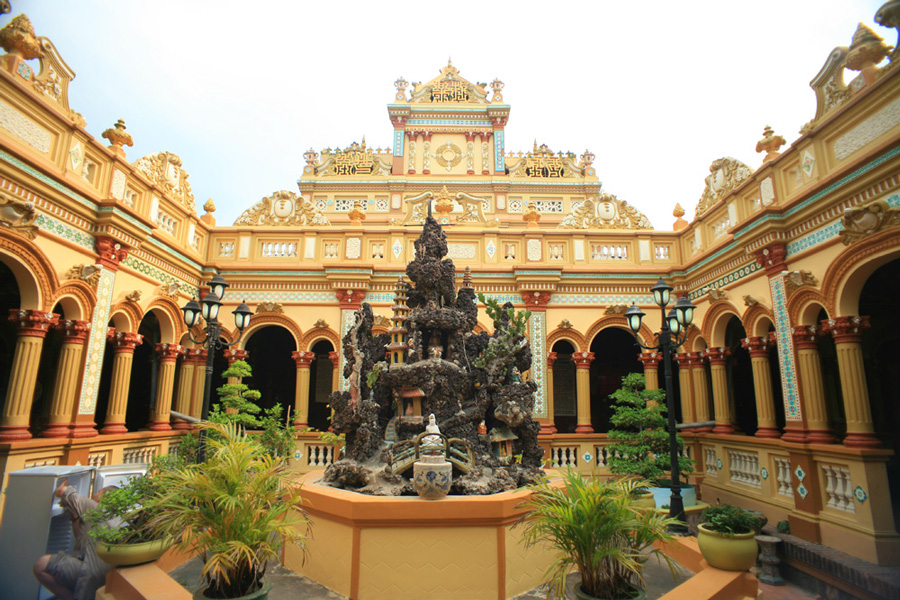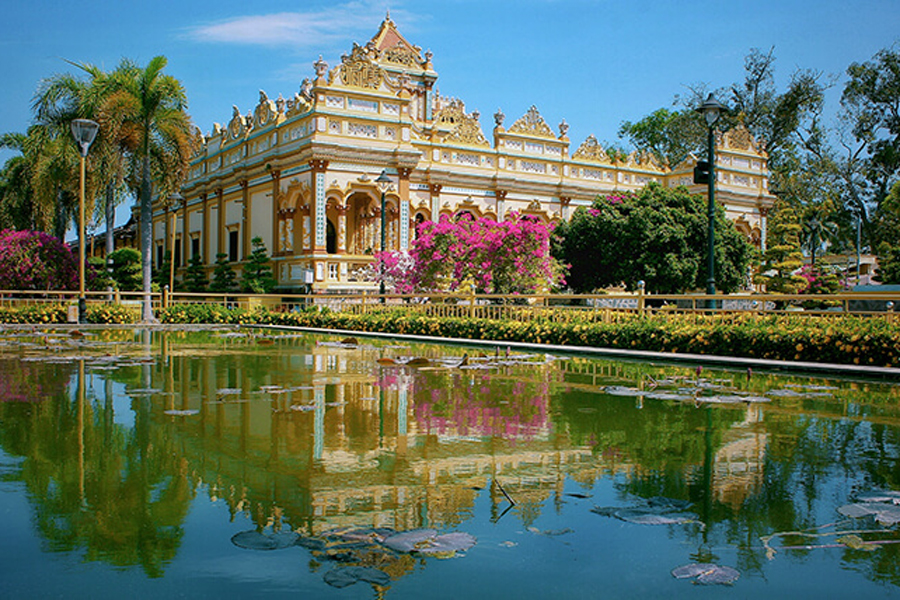Vinh Trang Pagoda

Vinh Trang Pagoda, nestled in the heart of the Mekong Delta in Vietnam's Tien Giang Province, stands as a captivating testament to the nation's rich cultural tapestry and spiritual heritage. Built in the 19th century during the Nguyen Dynasty, this Buddhist temple is a harmonious blend of Vietnamese, Khmer, and Chinese architectural styles, showcasing intricate carvings, vibrant mosaic tiles, and serene garden courtyards. Its three-tiered entrance gate welcomes visitors into a realm of tranquility, where statues of Buddha and ancient relics whisper tales of centuries past. Inside the main hall, ornate altars and vivid murals depict Buddhist teachings and Vietnamese folklore, inviting contemplation and reverence.
 Visit Vinh Trang Pagoda in Tien Giang to enjoy the unique architecture
Visit Vinh Trang Pagoda in Tien Giang to enjoy the unique architecture
Beyond its architectural splendor, Vinh Trang Pagoda serves as a beacon of community unity, hosting religious ceremonies, festivals, and charitable endeavors that resonate throughout the region. With its timeless beauty and profound spiritual significance, Vinh Trang Pagoda stands as a cherished symbol of Vietnam's cultural identity and enduring devotion.
The history of Vinh Trang Pagoda is a story of Vietnamese culture, spirituality, and architectural ingenuity. Dating back to the 19th century, during the reign of Emperor Tu Duc of the Nguyen Dynasty, its inception marked a significant milestone in the region's religious landscape. Initially established as a modest place of worship amidst the verdant landscapes of the Mekong Delta, the pagoda's humble beginnings belied its eventual transformation into a majestic sanctuary of profound cultural and spiritual significance.
 Vinh Trang Pagoda history
Vinh Trang Pagoda history
Throughout its history, Vinh Trang Pagoda has weathered the winds of change, bearing witness to the ebbs and flows of Vietnamese history. Over the centuries, it underwent numerous renovations and expansions, each iteration adding new layers of architectural splendor and cultural depth. Drawing inspiration from a synthesis of Vietnamese, Khmer, and Chinese architectural styles, the pagoda emerged as a harmonious blend of diverse cultural influences, reflecting the region's vibrant multicultural heritage.
Despite facing adversities such as natural disasters and periods of political unrest, Vinh Trang Pagoda stood resilient, a steadfast beacon of spiritual devotion and community unity. Its tranquil courtyards, adorned with lush gardens, serene ponds, and intricate statues, have provided solace and inspiration to countless generations of worshippers and visitors alike.
 Vinh Trang Pagoda history
Vinh Trang Pagoda history
Beyond its architectural grandeur, Vinh Trang Pagoda has played a pivotal role in the social fabric of the Mekong Delta, serving as a center for religious ceremonies, cultural festivities, and charitable endeavors. Its halls echo with the prayers and aspirations of devotees, while its corridors bear witness to the acts of compassion and generosity that define its legacy.
Today, Vinh Trang Pagoda stands as a cherished symbol of Vietnam's cultural identity and spiritual heritage, attracting pilgrims and tourists from across the globe. Its history is a testament to the enduring power of faith, resilience, and cultural exchange, encapsulating the timeless values of compassion, wisdom, and peace that resonate throughout the ages. As it continues to inspire awe and reverence in the hearts of all who visit, Vinh Trang Pagoda remains a living testament to the enduring spirit of Vietnam's cultural and spiritual legacy.
You may also like: Saigon & Mekong Delta cycling 5 days/4 nights
The best time to visit Vinh Trang Pagoda is during the dry season, which typically occurs from December to April. During this time, the weather is generally more favorable with lower chances of rain, making it ideal for exploring the pagoda's outdoor gardens and intricate architecture. Additionally, visiting during the dry season allows for clearer skies and better visibility, enhancing the overall experience of admiring the pagoda's beauty and taking photographs.
 Vinh Trang Pagoda: Uncover the essence of spiritual peace
Vinh Trang Pagoda: Uncover the essence of spiritual peace
It's also worth considering visiting Vinh Trang Pagoda during special Buddhist festivals or cultural events, such as Tet (Lunar New Year) or Buddha's birthday celebrations, which usually occur in the spring. These festivities add an extra layer of cultural richness and vibrancy to the pagoda's atmosphere, providing visitors with the opportunity to witness traditional rituals and experience the local culture firsthand.
To reach Vinh Trang Pagoda in My Tho, Tien Giang Province, Vietnam, visitors have several transportation options at their disposal. Those coming from nearby cities or provinces can opt for the convenience of private transportation, either by hiring a taxi or renting a car, utilizing well-maintained highways and roads that connect to My Tho. Public buses and intercity coaches offer a budget-friendly means of travel, with routes connecting My Tho to various cities in the region. Once in My Tho, travelers can easily hire a taxi or motorbike taxi to cover the remaining 3 kilometers to Vinh Trang Pagoda. For a more scenic journey, boat rides along the Mekong River provide a unique and picturesque approach to reaching the pagoda, often included in boat tour packages of the Mekong Delta. Additionally, organized tours departing from Ho Chi Minh City and other tourist hubs offer convenient day trips to My Tho, incorporating visits to Vinh Trang Pagoda alongside other notable attractions in the area. Regardless of the chosen mode of transportation, careful planning and consideration of schedules and routes ensure a smooth and enjoyable journey to this cultural landmark.
You may also like: Ngoc Son Ngo Luong Trek 4 Days